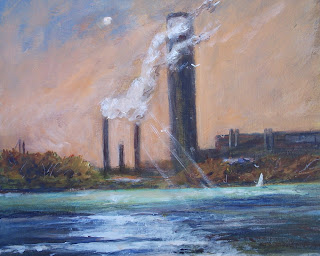
Here is the more or less completed painting (of Fawley Oil Refinery, from the Solent). I think it's a little skewed - had trouble taking the photograph, and it looks as though the chimneys are leaning slightly leftwards; this is complicated by a rather interesting (I lead a dull life..) optical illusion: the faint beams of light give the impression of an even greater lean, in the photograph, which isn't in fact apparent in the painting.
Anyway - it would have been quicker to say I'm a rubbish photographer, I suppose...
As you can see, this is a combination of glazing in transparent colour over the original underpainting, plus some thicker, opaque paint in places. Once upon a time, most paintings were created this way (in oil; this of course is acrylic); then alla prima came in, where painters tried to create an instant impression by laying down solid blocks of colour. The latter approach tends to lead to a somewhat looser effect; its drawback is a loss of luminosity.
This isn't completely finished yet, just one or two touches to add - but they'll be more obvious to me than anyone else, so - this is about it. Not on my website yet, but there are one or two changes there (www.isleofwightlandscapes.net) on the Buy page.

